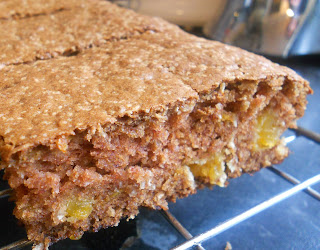Ekadasi Cake- gluten-free
Okay, so Ekadasi is all about cooking less and praying more, but there are times when you might need a cake recipe, especially if you have a young and hungry family who need encouraging to keep grain-free all day, or if there is a special appearance day on which Ekadasi rules are followed, but a celebratory feast is also called for- such as Lord Ramacandra's appearance (Tuesday 12th April here in the UK).
This cake is made with buckwheat flour. Great River Organic Milling, Organic Specialty Buckwheat Flour, 25-Pound Package Flour, Buckwheat, Organic, 25# Bulk As buckwheat is actually a member of the rhubarb family its seeds are not considered to be true grains so it is permissable on Ekadasi. Despite the fact that I now have a whole queue of draft posts awaiting publication, I'm posting this recipe next because I think it's one of my most versatile cakes yet: it can be vegan or not and it is wheat and gluten-free. It can be made, as here, to Ekadasi specifications, or made with soya milk on other days...you can change the flavouring too. Excited yet? Well anyway here's the recipe:-
As buckwheat is actually a member of the rhubarb family its seeds are not considered to be true grains so it is permissable on Ekadasi. Despite the fact that I now have a whole queue of draft posts awaiting publication, I'm posting this recipe next because I think it's one of my most versatile cakes yet: it can be vegan or not and it is wheat and gluten-free. It can be made, as here, to Ekadasi specifications, or made with soya milk on other days...you can change the flavouring too. Excited yet? Well anyway here's the recipe:-
These amounts make a cake in a 9x7" (22.5x18cm) tin or the round equivalent. It makes 8 portions, so if you are catering for more, just scale up the quanities and it should work fine; just be cautious with the liquids and add less juice if the mixture seems too runny- follow your baking instincts!
250g buckwheat flour
1 tsp ground ginger
2 tsps bicarbonate of soda (NOT baking powder)
150g demerara or soft light brown sugar
4 tabs desiccated coconut
10 semidried apricots*, finely chopped (*note: if you are going to use dried fruit on Ekadasi, make sure it does not contain vegetable oil. In the UK, Aldi apricots and Sunmaid raisins are okay)
200ml almond milk/fruit juice
2 tabs lemon juice (about 1 smallish ) lemon
50ml peanut or sunflower oil (organic cold-pressed sunflower oil has a strong smell and taste though)
the grated rind and juice of 1 orange
The flavour of the finished cake is not especially gingery or coconutty: I suspect you could add more of either of these ingredients to get a more distinctive taste.
This cake is made with buckwheat flour. Great River Organic Milling, Organic Specialty Buckwheat Flour, 25-Pound Package Flour, Buckwheat, Organic, 25# Bulk
These amounts make a cake in a 9x7" (22.5x18cm) tin or the round equivalent. It makes 8 portions, so if you are catering for more, just scale up the quanities and it should work fine; just be cautious with the liquids and add less juice if the mixture seems too runny- follow your baking instincts!
250g buckwheat flour
1 tsp ground ginger
2 tsps bicarbonate of soda (NOT baking powder)
150g demerara or soft light brown sugar
4 tabs desiccated coconut
10 semidried apricots*, finely chopped (*note: if you are going to use dried fruit on Ekadasi, make sure it does not contain vegetable oil. In the UK, Aldi apricots and Sunmaid raisins are okay)
200ml almond milk/fruit juice
2 tabs lemon juice (about 1 smallish ) lemon
50ml peanut or sunflower oil (organic cold-pressed sunflower oil has a strong smell and taste though)
the grated rind and juice of 1 orange
- Combine all the dry ingredients in a bowl with the apricots
- Measure out the liquids in a separate container
- Add the liquids to the dry ingredients, beating well for about a minute.
- Place in the prepared cake tin (oiled and floured, or dampened if you are using silicone)Wilton 2105-4923 24-Cavity Silicone Brownie-Squares Baking Mold
and bake in a preheated oven at 180C for about half an hour, or until a skewer inserted into the centre of the cake comes out clean.




Trust you to make a farali cake! Will try it out in the next navratri. Won't my guests be surprised to have cake at asthami dinner!
ReplyDeletetab is tablespoon and tsp is teaspoon- sorry for any confusion!
ReplyDeletetab, or tablespoon is 15ml.
ReplyDeleteAwesome! I will definitely give this one a try for Ekadasi in a few weeks... My partner is a Bhakta and I'm always looking for new egg-free recipes to make for him as well. Happy to have found your blog!
ReplyDeleteHari Bol!
Thanks:) hope you find the recipes here useful and enjoyable. Don't hesitate to get in touch if you have any queries.
DeleteIn my old (70's issue) Hare Krishna Cookbook the abbreviations Tsp and tsp are used to distinguish between Tablespoon and teaspoon. I find it very helpful and easy to remember- big T, big spoon!
ReplyDeleteSorry, my mistake, the cookbook uses T. and t. respectively
ReplyDelete